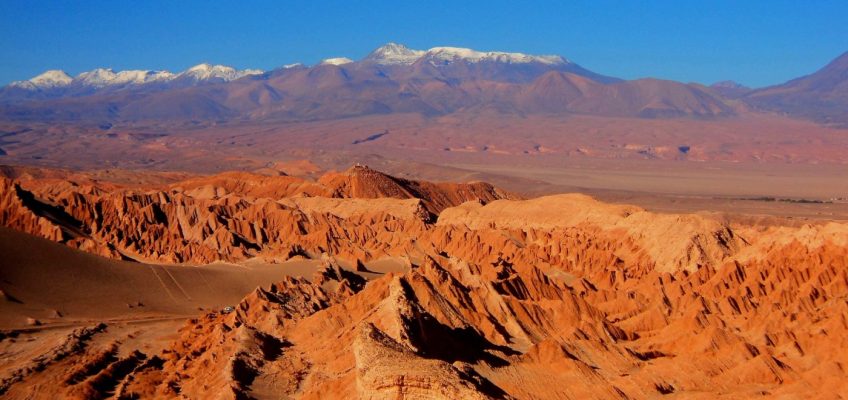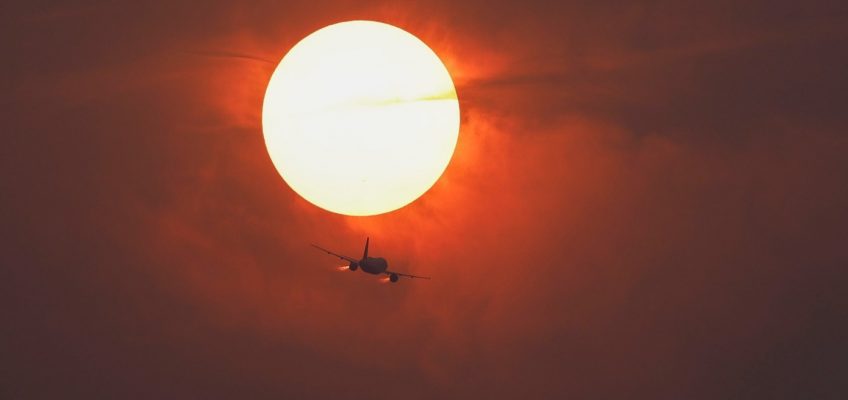Glittering salt flats. Sky-poking volcanoes. Teal lagoons painted pink with flamingos. These are the wonders that await guests traveling to the resort town of San Pedro de Atacama — an oasis amid the greater Atacama Desert of northern Chile, which is the driest (non-polar) place on Earth.
The 51-room Our Habitas Atacama, which opened on Sept. 15, is shaking things up as the most recent opening in a destination that rarely sees them. “The timing for Habitas is bang-on because the Atacama is red-hot right now,” says Harry Hastings, founder of bespoke travel company Plan South America. He says it’s one of his best-selling destinations.
What sets the property apart, Hastings says, is not just the design and culinary ambitions but something far simpler: With starting rates from $300 per night, it’s the only luxurious hotel in the area that isn’t priced on an all-inclusive basis. It gives travelers rates far lower than those of such competitors as Awasi, Nayara and Explora, which can charge $1,000 nightly per person.
Anyone who’s flown on a budget airline knows that unbundled rates can add up fast — particularly when the point of coming to a desert is to get out and explore it, perhaps by horseback riding across towering sand dunes, hiking through geysers, or quad biking across the Valley of the Moon. Still, Hastings says he’s been recommending the property to clients who want the freedom to explore the desert at their own pace.
The Atacama outpost is the latest landing spot for Our Habitas, a company born out of Burning Man whose ethos revolves around sustainable design, cultural experiences, and community empowerment. The company’s first outpost in South America, it exemplifies the brand’s quick-fire ascent: Our Habitas has grown since 2016 from a single boho-chic hotel in Tulum, Mexico, to 11 locations across four continents. (Recently, the brand raised eyebrows by announcing a $400 million expansion in Saudi Arabia, where it is building a circuit of at least four individual lodges.)
Chief Executive Officer Oliver Ripley says that a notable aspect of the property, a conversion of the former Altiplanico Hotel, is how it preserved the sturdy adobe bones while upgrading its interiors—a combo that was intended to lower the carbon footprint (and cost) of building the new lodge.
When seeking expansion opportunities for Our Habitas, Ripley says, “There is always an emphasis on discovery, adventure (and) nature.” In the Atacama, he found them all, thanks to the destination’s strong Atacameño identity and otherworldly landscapes in which NASA tests instruments for use on Mars.
On the streets of San Pedro de Atacama, Chile. (Dmitry Chulov/Dreamstime/TNS)
Here’s a look at some of the most unique features at the new Our Habitas property, from a steamy sweat lodge to its hyperlocal desert cuisine.
Local design touches abound
Setting foot inside the property’s 51 rooms is meant to feel like entering a traditional Atacama home, with thick clay walls made of temperature-controlling adobe and grass roofs lined in brea, a native flowering plant. Pottery and wall tapestries come from Atacameño artisans who live in neighboring ayllus (Indigenous-run communities), while the sturdy wood furnishings come from Chilean craftspeople in the nation’s forested south.
Upcycled materials are a design feature
In refurbishing, Our Habitas made a point of “reusing and relocating existing elements of the hotel in new and exciting ways,” says Ripley. That’s why you’ll find the steel security gate from the former Altiplanico serving as the base of the new bar. Similarly, bricks from an exterior wall now tile the restaurant, and clay sun blockers once used to shade the parking area act as roofing for the wellness zone.
The spa highlights Atacameno practices
A highlight at the Atacama property is the clay sweat lodge, or temazcal, which is common among Indigenous groups of the Americas. Users set forth their intentions for the experience as a trained guide from the Indigenous community of Collasuyo pours herb-infused water atop fiery volcanic stones, heating the dome-like lodge with increasing levels of steam. The idea is to detoxify your body and remove stress in your mind. Additional wellness treatments inspired by Indigenous practices include a holistic Willka Kuti massage named after an Indigenous Amyara solstice celebratio, which uses using energizing coca leaf oil. Another is a Maqui Facial, which employs the endemic maqui berry, which is rich in antioxidants. Chakra alignments and Andes-inspired meditation sessions round out the lengthy wellness menu whose rates run from $100 (for a 60-minute Maqui Facial) to $170 (for a 90-minute Willka Kuti massage).
Dishes tend to tell a story
The onsite restaurant Almas (“souls,” in Spanish) has an “earth-to-table” approach that tries to share the history of the Atacama through flavor, using as many endemic ingredients as possible. Several dishes feature native herbs, including a red quinoa risotto with salty cachiyuyo leaves or the fresh razor clams from the Atacama coast, sprinkled with minty and citrusy rica-rica. (It adds a great punch to pisco sours, too.) Others showcase local cooking techniques, like the lamb chop baked in a traditional clay oven. Chef Guillermo Riviera Reyes’s menu features kalamata-like olives from the nearby Azapa Valley; plates sprinkled with a prized, high-altitude oregano from Socoroma; salad dressings based around the hazelnut-like legume chañar; and a flan made with the tamarind-shaped pods of the algarrobo trees that tower above the property.
Excursions reveal unearthly sights
Our Habitas is rare among San Pedro’s upmarket hotels in that it does not include guided adventures in its (much lower) room rates. Guests choose à la carte among a lengthy list of excursions (from $100-275 per person), including hikes and scenic drives up to the high-altitude plateau, or Altiplano, at the border with Bolivia and Argentina. Here, in parks such as Los Flamencos National Reserve, travelers find flamingo-filled lakes, blinding-white salt flats and lagoons so saline that swimmers bob on the surface like human ice cubes. Further north is the famed El Tatio complex: The largest geyser field in the Southern Hemisphere is filled with gurgling mud puddles, sputtering fountains and prismatic pools.
Cultural experiences are free
Although the hotel isn’t all-inclusive, some wellness activities (like yoga classes) and most of the cultural programming come without further charge — all part of the hotel’s plan to “emphasize the importance of experience,” says Ripley. Sound baths and movement classes help visitors tune in to the environment and tune out unnecessary noise. By night, the Atacama sky — studied by astronomers the world over due to its almost complete lack of cloud cover, moisture or light pollution — offers priceless spectacle. Local Atacameno musicians regularly play Andean music (think panpipes and flutes) in the evenings. Workshops on ceramics or medicinal plants give guests a greater appreciation for local arts and traditional wisdom, though they are conducted by a staff that includes just two Indigenous members. (Ripley and hotel staff declined to discuss the extent to which the Indigenous community helped shape the cultural programming; the programs are generally offered multiple times a week.)
The location combines village life with arresting vistas
The hotel’s location on the edge of San Pedro (population 5,000, about the size of Moab, Utah) makes it easy to explore village museums, cafes and craft markets by foot — the main plaza is merely a 12-minute walk down dusty roads — while also enjoying serene desert views that properties in town can’t offer. “I think you’ve got the best of both worlds,” says Hastings. “There’s easy access to town and easy access to get out of it.”
The grounds are meant for walking
Outdoor pathways wind through the property past native vegetation, including spiky cacti, feathery foxtail grasses and a newly planted herb garden. Ripley says this “encourages guests to wander around and take different daily routes to explore and discover new corners.” The ultimate goal, he adds, is “total immersion into the natural world.” Still, plenty of space is designed for connecting and communing with fellow guests.
Cocktails by the pool come with a view Guests kick back in loungers under the scorching sun with pisco cocktails and sauvignon blancs or semillons from Chilean valleys with cooler climates, such as Itata or Casablanca, as they tan by an L-shaped pool overlooking a bushy tapestry of desert flora. The poolside menu features such light plates as ceviches or lamb-filled empanadas.
The rooms have personality The hotel includes four distinct room types, all designed to sooth sun-weary eyes with cooling earth tones. The Pioneer Studio (from $300) is the smallest and sleeps two in a plush, king-sized bed. The Adventure Room (from $345) is slightly larger, with an additional lounge chair. The Explorer Suite (from $360) is nearly double the size of the Pioneer Studio and includes a desk area useful for remote work. The Trekker Villa (from $450) is the largest option; its private terrace comes in handy after sundown as the Milky Way flickers in the inky sky. Standout room features include wood-carved floor lamps with hand-woven shades and outdoor rain showers that are ideal for washing away the dust of the desert.
___




